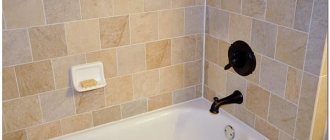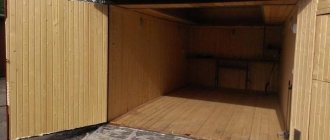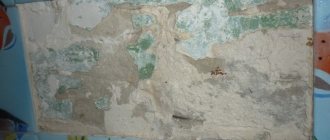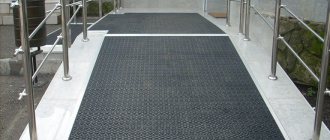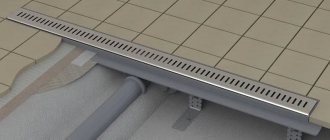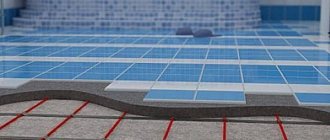Cutting the plate without chipping
Porcelain stoneware is a high-strength material. It has virtually no pores, does not absorb water and does not crumble. It is very difficult to even scratch it. Therefore, home craftsmen have a question about how to cut porcelain stoneware without chipping and whether this is even possible. We must admit that this is theoretically possible, but in practice it happens very rarely. More often, small chips remain on the cut, which have to be sanded.
To keep them as small as possible, experienced professionals advise following these recommendations:
- Cut the part from the top side. Most chips in the material occur where the cutter exits the insert.
- The thinner the selected cutting disc for the grinder, the lower the likelihood of chipping.
- At the beginning of the cutting line of the cut and at the end of it, reduce the speed of the cutter.
- When working with a mechanical tile cutter, you should apply more pressure on the lever than when cutting regular tiles.
- Make the cut slightly to the right of the intended mowing line so that it remains on the cut piece. Then it will be possible to remove unwanted chips with a grinding machine.
It is very important that the tool is of high quality and suitable for working with the selected material. Otherwise, it is almost impossible to get a beautiful cut without chips. If they do appear, which happens most often, the defects should be sanded down. You can use sandpaper or a diamond sponge.
The best option is a grinder with a special attachment. This is the so-called turtle or flexible diamond wheel. They are distinguished by the diameter of the particles of diamond coating applied to the surface. The turtle can only work with a grinder, the model of which provides the ability to regulate the number of revolutions. If it is higher than three thousand per minute, the nozzle may fly off the axis.
Angle grinder (grinder) - multifunctional tool
Cutting tiles with a manual or electric tile cutter requires the purchase of these tools, which is not always justified in the case of household work. In addition, after tiling work, you will no longer be able to use these tools anywhere.
For a home craftsman, a good solution may be to use an angle grinder (grinder). But working with this tool has its own specifics.
First, you need to decide on the size of the angle grinder itself. The best option for cutting tiles would be a grinder with a 125 mm disc. It is convenient to hold and manipulate.
Angle grinder with 125 mm disc
It is better not to use grinders with a disc diameter of 230 mm for such work. The tool is very bulky, which makes manipulation difficult and significantly degrades the quality of the cut. It is permissible to use an angle grinder with a disc diameter of 180 and 150 mm, but only if cutting thick tiles or porcelain stoneware.
A grinder can cut all types of ceramic tiles - wall, floor and even porcelain tiles. Without any problems, you can make straight cuts, at an angle and some curved ones.
To simplify the work, you can consider purchasing a special attachment for an angle grinder - “Slider”.
Angle grinder with Slider attachment.
Let's take a step-by-step look at how to cut ceramic tiles with a grinder without chipping:
To cut ceramic wall or floor tiles, you must use a solid diamond blade for dry cutting.
Disc for cutting ceramic tiles.
The tiles are fixed in a stationary state using clamps.
Step 3. Cut.
The incision is made towards you, the disc is positioned perpendicular to the surface. Sometimes the grinder moves back and forth to reduce the heating temperature. To prevent chips from forming on the front surface, the angle grinder must be tilted slightly to the side. If the cutting angle is less than 90, then chips will not form.
Step 4. Revision.
Abrasive processing of edges when operating an angle grinder is necessary. If you used an abrasive disc with a special “Slider” attachment, you will have to sand the edge less, since the number of chips is minimized. Grinding the edge is done with the same grinder used for cutting, or with emery cloth attached to a block.
How to cut porcelain tiles with a grinder:
Next, we’ll look at how to cut porcelain tiles at home. To cut porcelain stoneware, it is necessary to choose solid diamond-coated wheels designed for wet operation.
When choosing a wheel, pay attention to the maximum permissible rotation speed, it must correspond to the rotation speed of the angle grinder
Disc for cutting porcelain tiles.
Cutting porcelain tiles must be carried out with a constant supply of a small amount of water. Otherwise, the coating on the disk will not last long and it will quickly cease to perform its functions. Therefore, before work, you need to prepare a plastic bottle of water by first piercing a hole in the bottle cap.
Step 3. Res.
By moving towards you, you need to apply a thin groove on the surface of the porcelain stoneware. Then the cut line must be moistened with water and again make a shallow cut, moving towards you. These operations must be repeated until the tiles are completely cut.
Step 4. Revision.
At the bottom of the cut, the tile may have roughness. To refine it, you need to turn it over to the reverse side, clamp it with a clamp and use an angle grinder and a diamond disk to slightly grind the edge.
How to cut porcelain tiles with a grinder without chipping
Almost every home craftsman has an angle grinder or grinder That's why it is most often used to cut porcelain tiles . Unfortunately, it is almost impossible to make such a cut without chips, but minimizing their number is quite possible. For this, it is very important to choose the right disk. He must have:
- high-quality diamond coating;
- marking confirming that the device is intended for cutting porcelain stoneware;
- minimum possible thickness;
- continuous cutting edge.
An angle grinder is a potentially dangerous tool, so do not neglect safety rules. You should take care of protective equipment. The kit includes:
- Wear a respirator, as cutting produces a large amount of dust.
- Safety glasses to prevent possible disc fragments from getting into your eyes.
- Special clothing.
- Earplugs or headphones to protect your hearing from loud noise.
It is not recommended to neglect protective equipment, even if you plan to cut several plates.
Correctly cutting porcelain tiles using a grinder is quite simple if you follow the instructions:
- We are preparing a place to work. We lay a backing on the leveled surface to protect the base. You can choose penoplex, polystyrene foam, etc.
- Place the piece face up on the base and mark the cut area on it. To reduce chipping, glue a strip of masking tape onto it and draw a cutting line along it.
- Place a metal corner on top of the tile along the cutting path and secure it with clamps. This will allow you to make an accurate cut. This is a must when cutting thick products.
- Let's launch the grinder. We cut the part at a time, directing it “away from ourselves”. To get a smooth edge, cut off the fragment so that the marking line remains on the product. It will be removed during the grinding process, and the tile will retain its specified size.
- Remove the masking tape and, if necessary, sand the end of the part.
If the plate is thin or a perfectly even cut is not required, you can simplify your work. The grinder does not make a cut, but only a cut. After which the fragment breaks off with a sharp, strong movement.
Using a grinder to cut porcelain tiles is very convenient. First of all, because this is the most affordable of all the devices that can be used. They can make cuts of various shapes, including any curved one. However, the grinder is dangerous, you need to work very carefully. It is very dusty and noisy.
Diamond wheel
A tool for cutting ceramic tiles for an angle grinder with diamond coating is the most expensive, but at the same time the highest quality option for attachments for an angle grinder. What can a diamond wheel cut?
- tile;
- stone;
- plastic;
- tree;
- ferrous and non-ferrous metals;
- concrete;
- marble.
The carbon coating on the nozzles has different hardness and composition.
Diamond attachments for grinders are also solid and segmented. There is another variety - turbo circles. They are used where you need to cut tiles at an angle at high speed.
Metal circles
For professional use, diamond-coated metal discs are used. The service life and quality of such equipment depends on the intensity of spraying. The price and reliability of this type of equipment is higher than that of stone.
Stone discs
Sharpening bits are most often made from stone. They provide a solid base with a minimum thickness of 6 mm. Thanks to their solid base, stone discs are ideal for sharpening tools that conventional thin blades cannot handle.
As a rule, stone discs are not suitable for cutting tiles due to their large thickness. But they can make the tools at hand sharper without much effort. A stone wheel with sandpaper petals glued on is suitable for sanding work. It is recommended to clean the tiles with a soft abrasive marked 20, 150, 180.
Glass cutter
Since the principle of operation of a tile cutter and a glass cutter is similar - to make a groove on the outer covering - the latter is often used when the former is not available.
A glass cutter is a small pen-like device with a diamond-coated blade instead of an ink pen. When working with it, it is advisable to also soak the tiles in water for 30–40 minutes.
After this time, you should mark the outside of the tile with a pencil or marker, apply a ruler to the resulting line and run the glass cutter in one not very strong movement. Then you need to place a pencil or wire under the resulting groove and press on the tile from the sides parallel to the cut. If you press too hard, chips will form in the glaze.
There are also oil glass cutters. Inside the “handle” there is a reservoir that is filled with a mixture of kerosene and machine oil. Due to this, better glide is achieved, which means there are fewer chips on the enamel.
This type of cutting takes quite a long time, so it is not suitable for large volumes. Difficulties may also arise when working with thick floor tiles - most likely, you will not be able to break them evenly, even if you place a pencil under the markings.
How to saw porcelain tiles with a grinder without chipping
There are two ways to cut porcelain tiles. The first is to apply markings with a depth of 1-2 mm in a circle along the mowing line, and then split the porcelain stoneware into two halves, as is done with a tile cutter. The method is quite risky and requires a good eye and precise dosing of effort. The advantages include an order of magnitude higher material cutting productivity. The disadvantages include the unpredictability of the result and a high percentage of defects.
The second method is the classic cutting of porcelain stoneware to the full thickness of the tile. It results in a lot of dust, the process takes quite a long time, but the result is a very high-quality and fairly even cut.
READ What lubricant to lubricate the gearbox of an angle grinder
In any case, when using a grinder, the seam turns out to be uneven. Visually, the fishing line looks perfectly straight, but as soon as you turn the cut plates over and apply them to the factory edge or metal ruler, all the irregularities will immediately become visible. An example of cutting porcelain stoneware with a grinder without chipping is shown in
A circular saw
A circular saw can be used to cut porcelain tiles. To do this, you need to replace the saw blade with one that is suitable for cutting tiles.
The disadvantage of this method is the need to manually feed the tiles onto the disk. Carelessness and any deviation from the trajectory can lead to injury or a poor cut.
Features of working with porcelain stoneware
Porcelain stoneware material is particularly durable and reliable. After all, it is made of natural stone. To cut porcelain stoneware without chipping with a grinder, like tiles, you need to use thin segmented discs up to 1.5 mm thick with intense continuous diamond coating. This will reduce the likelihood of overheating.
Porcelain tiles should be cut in the same way as tiles.
Straight cutting or straight cut
This is the standard method for cutting ceramic tiles. It involves dividing the material along straight lines.
- Initially, you need to mark the cutting line. To do this, use a ruler and marker.
- Place the workpiece on a straight surface and remove all excess.
- Secure the tile with a vice.
- Make the first cut to a depth of 1-5 mm, depending on the thickness of the material. When entering the tile, reduce the speed and then increase it.
- The grinder needs to be driven away from you, at the same speed, evenly.
- When exiting the material, you should also slow down to avoid chipping.
- Break the workpiece along the cutting line of the cut.
- Clean the edges with a jig.
Important! When making a cut, you must adhere to the chosen trajectory as much as possible.
45° cutting
In order to perform high-quality work in this case, you need to use a metal circle coated with diamond.
- Mark the cutting line at a 45 degree angle with a marker.
- If possible, fix the material face down.
- Make the first cut with a grinder.
- Repeat if necessary to improve the result.
Important! When cutting tiles at an angle of 45 degrees, it is necessary not to reach 1.5-2 mm of the glaze, that is, only cut off the clay.
Solid dry cutters
This is a solid circle with diamond coating applied around the edge. This equipment is convenient for processing tile edges. After using a solid disc on tiles for an angle grinder, the edges of the material are as smooth as possible.
To cool, it is recommended to periodically wet the tiles and also spray them with a spray bottle.
Method of using a tile cutter
To make an even, correct cut of ceramic tiles with a special tile cutter, follow these steps:
- place the tiles in a tile cutter. The previously made marking line must coincide with a special mark on the tool;
— lower the handle onto the tile and move it with equal pressure and uniform speed in the direction away from you. The roller should cut through the icing to the same depth. One roller wiring is enough.
Warning! Performing several passes will not improve the result of the work, but, on the contrary, may worsen it. Due to microscopic discrepancies in the cutting on the glaze, the break turns out to be of poor quality!
— using special paws located near the roller, we break the cut tile into pieces. To do this, you need to press the lever sharply and firmly.
All models of tile cutters have a special metal tubercle on the platform. It has soft linings along the edges to prevent damage to the tile parts after a break. When the paws press on the edges of the tile, internal tension is created along the cut line and, with precise and correct placement, an even split into two parts occurs.
High-quality modifications of the tile cutter without any problems allow you to cut even 10 mm tiles at any angle - 40 or 30 degrees - it doesn’t matter. The tool will cope perfectly with any task.
Types of cutting ceramic products
Unlike a flat cutter, grinder allows you to perform different types of cutting. But each specific case has its own characteristics that need to be paid attention to.
Stone discs
The most budget option, but in terms of reliability it is inferior to all other types. When using it, the cutting thickness will be much thicker, and a lot of dust will be generated during operation.
During use, you need to monitor the condition of the stone circle. And as soon as chips appear on it, replace it.
Some tips about forgotten technologies
Are you going to lay the tiles yourself? Please note that the process is very labor-intensive and will require certain experience from the contractor. Beginners should be given some practical advice: if you use a grinder to cut tiles without a tile cutter, then you should not make sudden movements, because the diamond wheel will damage the part that should remain clean.
Do you think it is possible to cut tiles without a tile cutter?
Cannot
Also follow safety precautions, always use personal protective equipment against dust for the respiratory system and eyes. Shards can very quickly and easily damage the cornea, and dust can clog the airways.
Is it possible to cut tiles with a grinder?
A grinder can cut any type of ceramic tile. The only problem is that this type of work is quite traumatic and also requires a certain skill. However, this procedure will take more time.
Before making the main cuts, it is recommended to practice on rough pieces.
Stone discs
Stone discs are several times cheaper than dry cutters, but they wear out during operation and must be replaced with new ones. In addition, they are thicker than dry cutters, so the thickness of the mowing line when cutting with a stone attachment is wider and, accordingly, more dust is generated during operation.
In the process of cutting with a stone nozzle, you need to monitor the condition of its cutting edge - if a chip or burr has formed on the edge, the disk must be immediately replaced, since such damage can lead to destruction of the nozzle and injury.
Dry cutters
You can use a dry cutter to cut ceramic tiles without water cooling, but the duration of one continuous cut should not exceed 1-1.5 minutes, after which the disk is allowed to cool while rotating idle. When purchasing a dry cutter, they prefer a tool with continuous diamond coating.
If, during cutting, a continuous luminous spark-strip appears on the cutting edge of the dry cutter - the phenomenon of “licking” the metal, then the temperature at the point of cutting the tile in such a situation rises sharply, which is fraught with damage to the material. In this case, with a rotating dry cutter, you can make several cuts on any abrasive surface (concrete, plaster), and the disk returns to working condition.
- segmented;
- solid.
Additional tools
When cutting tiles for the first time by a non-professional, something may not go as expected. But additional tools will always come to the rescue and hide an uneven and rough cut.
Pliers or wire cutters
If a groove is made, but the tile cannot be broken evenly, you can bite off the excess pieces with pliers. Another option is to knock out this piece, which can lead to damage to the entire tile. The nippers will carefully remove the excess and perfectly adjust the tile to the required size.
They will also help to achieve a shaped cut if you make grooves on both sides of the tile, for example, with a nail. The only negative is that it is a very lengthy process, so large volumes cannot be made this way.
The nippers start working from the edge of the tile to avoid cracks and chips.
How to cut ceramics with a grinder
One of the tools used for cutting ceramic tiles is the Grinder - an angle grinder, commonly called an angle grinder.
The secret of how to cut tiles with a grinder, BUT without chipping!
The price range of various grinder models makes it accessible not only to professionals, but also to home craftsmen, so when using an angle grinder you need to know not only the capabilities of this power tool, but also the rules for handling it in order to avoid injury.
It is better to use a grinder with adjustable speed
At home, they use a small Grinder, designed to work with disks with a diameter of 100-125 mm and perform many operations. The tool can be equipped with a rotation speed controller.
Jigsaw
A jigsaw is an indispensable tool if you need to cut tiles along a curved line, and the required bends are quite sharp. However, using a jigsaw to cut into porcelain tiles is very difficult; this method is only suitable for ceramic tiles. Naturally, not just an ordinary saw for fibreboard is used, but a special diamond jigsaw file of good quality, since the tiles have increased strength. A circular saw is more suitable for cutting porcelain tiles.
Before making an internal cut with a jigsaw, you need to drill a hole whose diameter will be slightly larger than the width of the diamond file. You need to drill it, stepping back from the cutting line inward a few millimeters more than the radius of the drill so as to give a margin for possible chips during drilling.
Figured cutting of tiles with a grinder
If it is necessary to cut an oval-shaped figure from a ceramic tile, then short cuts are made with a grinder tangentially to the outer contour of the figure in order to cut off small fragments of ceramics to be removed. Upon completion of cutting, the surface of the cuts is refined with an abrasive tool until the lines are smooth and there are no chips.
When it is necessary to cut a shaped hole in a tile, the material is cut with a grinder exactly along the contour, gradually moving inward from it and increasing the depth of the cut. After cutting through the tile, the edges of the hole are finished with coarse sandpaper.
Features of figured carving
When carrying out repair work, there is a need for curved cutting of tiles. A grinding wheel, saw or cutter provides only a straight cut. The drill will allow you to cut a hole that can be connected with straight lines to the edge of the workpiece. But careful curvilinear processing of tiles requires experience from the master: a sudden movement can damage the workpiece. An abrasive tool is used to smooth the edges, but with force or heat the part cracks.
For curly cutting use:
- electric drill with a hole-cutting attachment;
- a jigsaw with a manual or electric drive, which allows you to process tiles made of soft material due to the elasticity of the cutting blade;
- electric tile cutter with additional degrees of mobility, providing cutting of the workpiece in several directions;
- a hand tool that allows you to chop off material in small pieces (with appropriate edge quality).
Experienced craftsmen perform shaped cutting using a grinder. Adhesive tape is glued to the surface of the ceramic tile and a marking line is applied, and then cuts are carefully made, moving from one area to another. The disadvantage of this method is the presence of marks from the disc on the glaze, which will have to be hidden with grout or an additional plastic frame.
No lateral load is allowed on the cutting tool, which can break and injure a person.
With the help of a ballerina
The tool consists of a central drill and an additional cutter that allows you to make round cuts. Apply paper masking tape to the glossy side and mark the center with a pencil. Then the tool is clamped into the chuck of an electric drill and the channel is drilled. Several holes located nearby allow you to get a curved edge. The disadvantage of the “ballerina” is the roughness of the cut, which requires additional grinding with a file or sandpaper.
Using a ballerina, round slits are made.
Ceramic tile nippers
To obtain a figured cutout, you need an electric cutting tool and special nippers. The design of the pliers uses jaws that allow you to break off small pieces from the workpiece. There are nippers with a carbide roller for trimming the glaze and then cutting the part. The handles of the tile cutters are equipped with stops to prevent damage to the jaws. The workpiece with the intended fault line is placed on a metal edge with the glaze down and the V-shaped part is applied to the opposite plane.
There are pliers of different sizes; the tool is used to remove strips up to 5 mm wide or to break off small fragments of tiles (the edge requires subsequent grinding). The nippers are only suitable for edge processing.
The tool jaws should be installed at a distance of 2-3 mm from the markings - the margin is necessary for subsequent grinding with a grinder or other tool.
What kind of discs are used to cut tiles?
To cut ceramics, special discs are required, which can be stone or diamond-coated metal. Stone ones are rarely used, as they are quite thick and wear down quickly, and generate a lot of dust during operation. The cost of stone discs is several times less than metal ones, but experts prefer to work last.
- solid;
- segmented.
It is preferable to process ceramics using solid discs. When working with such discs, there is a time limit: they cannot continuously cut for more than 1-1.5 minutes. Then you should let it cool with the grinder running at idle speed.
Segmented ones are designed for cutting paving stones, porcelain stoneware, natural stone or concrete.
The segments are designed for better cooling of the tool during operation.
READ Grinder motor brushes spark cause
Round holes
There are crowns that are designed to create circular holes in tiles. The maximum and minimum diameter of the finished hole when using crowns is quite small.
- The first value is three centimeters, the second is 8 cm.
- If you need a larger diameter, you can use a grinder or a ballerina drill.
- The crowns, as well as the grinder discs, have diamond coating.
Cutting porcelain stoneware
When performing repairs, not only the walls are covered. Porcelain tiles are laid on the floors in the bathroom and toilet - an artificial material that replaces granite and marble. Its cost is several times less than natural ones, but in terms of hardness and abrasion parameters, porcelain stoneware surpasses them. Recently it has become widespread. It can also be cut using an angle grinder.
To do this, you need to know the basic methods of processing material at home.
- It is necessary to choose the right cutting tool. It should say what it is used for: porcelain stoneware , hard ceramics, etc.
- To reduce chipping, choose a disc with a continuous cutting edge. The thickness should be minimal.
- We choose a cutting wheel with a high diamond coating height.
- The grinder must have a speed regulator.
After choosing a tool, prepare the workplace and begin cutting porcelain tiles with a grinder. To do this, you need to perform the following sequential steps.
- Place the material on a flat surface with thin foam or similar material underneath it.
- Securely secure the tiles to the surface using clamps.
- To reduce chipping, apply masking tape and make a mark along which you need to cut off the excess part.
- Prepare a vacuum cleaner to remove dust.
- You need to cut from the front side, moving the grinder away from you.
- It is recommended to cut not along the marked mowing line, but slightly to the side. This is done for subsequent grinding of the end of the porcelain stoneware to remove irregularities and chips.
By following these simple recommendations, you can cut floor tiles with high quality with your own hands.
Notched neckline
Often there is a need to cut a round hole in a tile. You can do the job correctly using an angle grinder if you have certain skills. To do this, mark a hole on the workpiece and trace the line with a felt-tip pen, marking the center of the circle. They begin to cut at a slight angle, slowly, along the inside of the mowing line, gradually passing along the entire circumference. Then the sectors are cut and taken out one by one, trimming the ceramics if necessary. The edges are finally processed with a file, obtaining an even circle. This processing is called dry cutting.
Such holes are usually cut for sewerage or ventilation.
When performing shaped processing of a workpiece, it is easiest to make rectangular cuts. In order for the cuts to be smooth and without chips, it is necessary to regularly change the cutting wheel. If you use segmented discs, then chips will certainly appear on the cut mowing line.
4. What to do when you need to make a hole in the glass?
Many people probably know that glass or a mirror can be cut using a glass cutter. But often during finishing work in the bathroom there is a need to drill through glass or a mirror. If it is not possible to take the mirror to a glass cutting machine, you can drill a hole yourself in the following sequence:
1. Apply paper tape to the back and front of the mirror;
2. A ring with a side height of 2 cm is made from children's plasticine and attached to the front surface of the mirror;
3. Turpentine is poured into the plasticine ring to the middle;
4. Drilling in turpentine is carried out using pobedit drills with a diameter of up to 6 mm or a cast round copper or brass core. You can also use an old flat soldering iron tip.
How to get rid of dust when cutting tiles
Cutting tiles with a grinder is not a very difficult task, but it creates a lot of dust. There are techniques that can reduce dust formation. Specialists use special tile cutters for this, but buying them for a one-time job is impractical due to their high cost. Therefore, when processing parts, craftsmen act differently. First, a layer of glaze is cut through - it produces almost no dust, the main dust appears when the layer of baked clay is processed. Then all that remains is to carefully break the ceramic tiles and sand the edges with an abrasive material.
A common way to get rid of dust is to moisten the workpiece. To do this, constantly add water to the working area of working with a diamond wheel. After each pass of the tool, it is necessary to fill the seam with water or install a special device to supply water to the work area. This device is attached directly to the protective casing of the angle grinder. As a result, the workpiece is processed without dust.
Water cutting of porcelain tiles
The most highly productive and at the same time accurate method of sawing very hard natural and artificial granites is considered to be the waterjet system. It allows you to cut out entire designs and three-dimensional images. The system is quite powerful and allows cutting porcelain stoneware up to 200 mm thick. At home, such equipment is not used for obvious reasons.
You can cut using water on a hydromechanical machine. The use of water or a water emulsion can significantly reduce the heating temperature of the tool and the porcelain stoneware itself. The result is less wear and higher surface quality. The emulsion is applied to the edge of the wheel, but not to the surface of the ceramic.
A diamond wheel mounted on the motor rotor is fed along the machine guides along the surface of the porcelain stoneware; coolant is supplied from a special reservoir directly to the cutting zone. This method is considered the most harmless, since almost all dust is washed off with water and removed from the surface of porcelain stoneware. It is clear that cutting material in this way is possible if you can find a separate room at home, for example, in a garage or shed.
Such machines have very high characteristics and cutting speed, therefore, if you plan to cut porcelain stoneware of complex shapes and sizes at home, then using a hydromechanical machine will be the best option.
Ceramic tile nippers
Nippers are a specific tool with short cutting blades, designed not for cutting, but for breaking off (biting) fragile material. They are needed as an auxiliary tool for processing the edges after cutting the tiles with a grinder or tile cutter.
Nippers for ceramic tiles come in two types: classic pliers and improved ones - with a roller cutting element.
Regular tile nippers.
Nippers with a roller cutting element.
In the latter case, the roller element performs the functions of a glass cutter; after running it along the surface, the tile breaks at the cutting site.
Nippers come in different sizes - you can buy several to break off small and large pieces. This tool is indispensable if you need to trim narrow edges about 0.5 cm wide.
Let's take a step-by-step look at how to work with ceramic tile nippers:
Step 1. Marking.
Traditional markings are made on the surface of the tile with a marker, sometimes without it.
Step 2. Fixation.
The element being processed is located on a horizontal plane or simply held firmly in the hand. If the nippers have a roller element, then when working, it is better to apply the tile being processed to the stop, and draw the line along a ruler.
Step 3: Biting.
Break off small pieces of tile; biting off large pieces may damage the tile.
Step 4. Revision.
Since the nippers do not perform cutting operations, but break off the material, the edges then remain uneven, with chips that need to be removed. After work, careful sanding of the edges is necessary.
The choice of tool and method of cutting tiles depends on its strength, working conditions, and the skill of the craftsman. The best way to cut tiles is up to each master to decide for himself. Knowledge about tools and the features of working with them will allow you to choose cutting devices consciously.
Features of cutting porcelain stoneware
It should be noted that cutting very dense and hard porcelain tiles at home is sometimes even easier than in the case of ceramic tiles. Anyone who doesn’t believe it can try cutting overheated ceramics made on old Soviet or Chinese equipment at home. In comparison, cutting porcelain tiles does not look so problematic.
to cut porcelain stoneware without chipping, although some craftsmen claim that this is fundamentally impossible to achieve. If this were indeed the case, then most walls and steps covered with porcelain tiles would have wide joints, crooked and unattractive.
It's not even a matter of the hardness of porcelain stoneware. The technology for manufacturing artificial granite is such that as a result of pressing and deep firing, the material is obtained with virtually no internal stresses, and this is the key to high quality cutting line cutting.
In order to accurately and accurately cut porcelain stoneware at home, you only need to fulfill two conditions:
- Select the correct cutting mode, ensure constant and uniform pressure with the cutting tool on the line for cutting porcelain stoneware;
- Select the appropriate tool for the specific conditions of cutting the material.
It is clear that at home, the possibilities of cutting the material are significantly limited, but even in an apartment it is quite possible to cut porcelain stoneware without a tile cutter, although the amount of dust generated when working with electrical machines is initially scary.
Professional waterjet equipment
It is hardly possible to cut porcelain tiles at home using a waterjet machine, since this is high-tech, bulky, and most importantly, extremely expensive equipment. Nevertheless, you should pay attention to it, since sometimes it is necessary to cut unimaginably complex figures from ceramic stone, and no other devices can cope with this task. Moreover, the quality of the resulting material will definitely amaze you, because the cut edges are almost the same as with factory pressing.
The operating principle of such a machine is quite simple, despite the complexity of the design itself. A stream of water mixed with tiny abrasive particles under enormous pressure is supplied through a special narrow nozzle. It is this water that cuts even the most durable, hard and viscous materials, even metals. Therefore, cutting porcelain tiles on such a machine will be very easy.
Since not everyone will be able to purchase such equipment for their home, you can find out, for example, where you can cut porcelain tiles in your city by simply making a request to any search engine. For a small fee, you can get perfectly cut tiles, exactly according to your measurements or patterns, so it’s worth considering this, least labor-intensive option.
Advice from professionals
Oddly enough, the greatest number of problems arise not even with the drive or tool used for processing porcelain stoneware, but directly with the diamond disc. The main complaint about diamond is the rapid loss of cutting ability. As a result, as feed and force increase, the edge of the wheel heats up and begins to lose diamond powder. If you try to cut at home in this mode for at least 10-20 seconds, then there will be nothing left of the expensive disk.
In this case, before each cut, the edge is cleaned and restored; at home, this can be done on ordinary red brick by making several small cuts. This removes soft material stuck to the diamond strip.
Experienced craftsmen, before cutting porcelain tiles, soak the material for 10-15 minutes in water. Artificial granite absorbs moisture very poorly, but a small amount of water still remains on the edge of the slab. As a result, the first time the cutting edge touches the surface, you are guaranteed to get a beautiful entry hole without chips.
READ Brushes on Grinders Spark Strongly
How to cut porcelain tiles with a circular saw
be cut without any problems using a more powerful cutting tool, such as a hand-held circular saw. Engine speed and power allow you to cut almost anything at home, from wood to metal profiles.
In order to cut porcelain stoneware, the tool must be retrofitted:
- First, the standard carbide-tipped saw blade must be replaced with a diamond wheel;
- Secondly, a ring-bandage is placed under the disk mount, thanks to which it is possible to dampen vibrations and uncontrolled bending of a thin and flexible diamond wheel.
The process of sawing material is not much different from working with an electric tile cutter; the only difference is that the engine power is noticeably higher. Therefore, you need to carefully control the feed of the diamond wheel with minimal effort, otherwise the porcelain stoneware will quickly overheat and crack.
If you need to cut porcelain tiles in large quantities, then there is no better option than an electric machine.
This method of sawing porcelain stoneware is considered the most productive, but at home it is used for short-term trimming of a small amount of material. You can only work in the yard, garage, shed, but under no circumstances inside a living space. The amount of dust that is generated when sawing even a small amount of material is approximately an order of magnitude higher than all other cutting methods. The only indisputable advantage of this option is that using a circular saw and a diamond wheel you can cut porcelain stoneware at 45 degrees.
What types of tools are there for cutting tiles, what is their difference?
All tools for cutting tilers can be divided into: manual tools (glass cutter, tile cutter, nippers) and power tools (electric tile cutter, angle grinder, jigsaw).
The choice of each tool depends on several factors:
- Scope of work performed. To cut one or two tiles, a glass cutter or grinder is enough; to finish an entire apartment or house, you need a tile cutter.
- The type and quality of the cut to be made. Straight and curved cuts are made with different tools; for drilling round holes, you may need diamond core bits and a drill. To cut thin wall tiles and thicker, more durable porcelain floor tiles, you need to use different equipment.
- Execution speeds. The larger the area on which the tiles are laid, the more advanced the tool for processing it must be.
- The amount of money that the master is willing to pay for the tool. Professional manual and electric tile cutters are expensive, but you can get by with more affordable tools.
Professional tilers usually have a full set of cutting tools to solve any task. To lay tiles yourself, the home owner does not have to purchase expensive professional equipment; you can do the work with inexpensive equipment or rent power tools from a hardware store.
How to cut porcelain tiles at home
From a technology point of view, there are two main ways to cut porcelain stoneware. To do this, you can use various tools and devices, but, regardless of the quantity and type of technical equipment, porcelain stoneware is still cut using two methods:
- Mechanical cutting of porcelain stoneware. In this case, the cutting line is removed from the cutting line with an abrasive tool;
- Piercing method. A deep scratch is cut on the surface of the porcelain stoneware along the future cutting line of separation. Next, a bending or shearing force must be applied to the porcelain stoneware, and the tile will split exactly according to the markings.
At home, you can use both methods, depending on the tools at your disposal, the amount of work and the thickness of the material. In addition, it is necessary to take into account the complexity of the configuration of the cutting line. For example, if you need to cut at home a tile that is quite large in size and simply will not fit into a tile cutter, then you will need to look for a diamond cutting wheel and a grinder. For cutting at home, this is one of the most reliable methods.
Having laid the tiles on a sheet of plasterboard, you can cut the porcelain tiles with a grinder along almost any trajectory; it is only important to take your time and evenly press the edge of the disk against the surface of the porcelain tiles. Otherwise, you can easily overheat the tile at the cutting point, which will lead to chipping.
How to cut porcelain tiles with a tile cutter
A tabletop or floor-mounted device for cutting any type of facing tile is a small frame with guides installed at the top and a carriage with a carbide head. The carriage is operated by a lever or by an electric drive. A simple and convenient mechanism for home use.
At home, a tile cutter turns out to be the most accessible tool for cutting porcelain stoneware
Before cutting porcelain tiles , the tiles are laid on the frame and secured with plastic or metal stops. This is necessary to ensure that the material does not move during the cutting process. Next, we bring the head to the edge of the tile until it touches and push the lever away from us; the carriage with a diamond or carbide tip evenly passes over the surface of the tile, leaving behind a deep scratch.
All that remains is to break the porcelain stoneware into two parts with a slight but sharp movement. One way to cut porcelain tiles with a manual tile cutter is shown in
- It is very easy and comfortable to cut porcelain stoneware at home; you can master the cutting technique even with minimal experience and qualifications;
- A minimal amount of dust is generated, which is very valuable at home, especially if you plan to lay porcelain tiles on a small area of the floor or wall.
An electric tile cutter is similar in design to a circular saw for processing and sawing wood. In order to cut porcelain stoneware, you just need to set the size of the strip to be cut, after which you can cut in unlimited quantities.
Home compact version of an electric tile cutter
HOW TO CUT OVERHEATED PORCELAIN TILES PERFECTLY EVEN AND ACCURATELY / PERFECT FINAL CUT ON ANY TILE
The disadvantages of the device include the fact that it is possible to cut only material of a certain shape and size, for example, it is very difficult to cut a thin strip of porcelain stoneware or make a cut of a non-standard, curved shape.
It is easier to cut a thin strip of porcelain stoneware with a grinder
How to cut porcelain tiles with a jigsaw
Quite an unusual way of sawing porcelain stoneware slabs. Using an electric or manual jigsaw to cut very dense and hard material always raises some doubts among beginners. However, cutting ceramics and porcelain tiles with a jigsaw is quite possible even at home, but only if certain requirements are met:
- The tool needs to be prepared for sawing porcelain stoneware. A thin, necessarily soft material, maybe paper or rubber, is glued onto the sole. This is done in order not to scratch or damage the front surface of the slab;
- The second step is to turn off the pendulum oscillation-movement on the hacksaw blade feeding mechanism, otherwise the saw will cut with chips on porcelain stoneware;
- A special type of diamond-coated hacksaw blade is used to cut tiles.
In addition, the stove itself must be securely fixed to the countertop using clamps, and a rubber strip must be placed under the porcelain stoneware to reduce vibrations. The method for cutting porcelain tiles is quite simple and does not require special skills, ideal for use at home. It is valuable that a jigsaw is very easy to perform shaped cutting of porcelain stoneware.
You can also cut tiles with a hand jigsaw, sometimes there is simply no other tool at home, although it will take several times longer, but it is possible to get a very accurate and high-quality cut. In this case, the side edges of the hacksaw blade are ground off, and emery powder is fed into the seam during the sawing process.
It is believed that this method is the cleanest of all mechanized options, which is especially important if you have to work at home, without an exhaust hood or a vacuum cleaner.
Sources:
https://domzastroika.ru/instrumenty/kak-rezat-plitku-bolgarkoy.html https://zonaplitki.ru/instrument/kak-rezat-plitku-bolgarkoj.html https://tehnika.expert/dlya-remonta/ bolgarka/kak-pravilno-rezat-plitku.html https://bouw.ru/article/rezka-plitki-iz-keramogranita-v-domashnih-usloviyah
Little tricks
These two methods do not exhaust all methods. With their help, you can get an acceptable result for any cuts at home. Round holes in the material are made with ordinary tools without any special nuances: drills with carbide coating, ballerina drills, crowns. The only difference is that due to the hardness of the material, the cutting tool will fail faster.
To solve the problem of laying tiles, you can use an integrated approach:
- The easiest way to cut tiles is with a manual tile cutter. It is recommended to cut the bulk of the tiles with it;
- Tiles with cut edges, covered with skirting boards or overlays. In this case, it will be enough to use a manual tile cutter or grinder (in limited cases);
- There are few tiles with an exact fit. Adjust by sanding;
- Lay all intact tiles. Depending on the available tools, adjust the tiles that are covered with baseboards and trims. The remaining elements should be accurately measured and marked on the tile. Either rent a professional tile cutter, or take it to the nearest construction company that has such equipment and cut it.
Advice! If you need repairmen, there is a very convenient service for selecting them. Just send in the form below a detailed description of the work that needs to be performed and you will receive proposals with prices from construction teams and companies by email. You can see reviews about each of them and photographs with examples of work. It's FREE and there's no obligation. Good advertising Most read
The relevance of the classic tile cutting tool
For cutting ceramic products, mechanical or electrical devices are chosen - it depends on the desired quality of the cut, the scale of the work and the characteristics of the material being processed. So, for home repairs, three options are considered: cutting the tiles with a glass cutter, a manual tile cutter, or a grinder.
Cutting tiles with a glass cutterSource globus-baumarkt.de
Glass cutter
The glass cutter consists of a rod, at one end of which a monolithic or hollow handle for oil is fixed, at the other - a cutting element: faceted diamond, pobedite cutter, carbide roller. The permissible thickness of the glass to be cut is 10, 8 and 7 mm, respectively. Often, the supporting steel platform has rectangular grooves for breaking off the blade.
Working with a glass cutter will be effective only if a deep furrow is formed in one pass. This is possible if the surface of the tile is smooth, which is not often found with artificial stone. As a result, such a tool is difficult. It is possible to cut porcelain tiles in a straight line, but not in a curved line.
Manual tile cutter
This tool is essentially an improved modification of the glass cutter. There is also a cutting element - a carbide roller. Only to increase the force is a lever mechanism that moves along tubular runners. To break the tiles, there is a small protrusion on the stand, and in the area of the cutter there is a lifting sole at a slight angle to the central axis.
Cutting tiles with a manual tile cutterSource bosch-do-it.de
Tile cutters are available in a wide range. The determining criteria for choosing a tool are:
- physical parameters of the tile;
- travel of the lever mechanism (dry, lubricated, on bearings);
- backlash of the cutter, or rather its absence.
They also consider the quality of the materials from which the device is assembled. For professionals, the functionality of the device is important. In addition to straight cuts, additional options allow you to cut holes.
Cutting porcelain stoneware with a tile cutter follows the same principle as with a glass cutter. A marking is applied and the tiles are placed on the stand according to it. A roller is placed along the line, which, under the pressure of a lever, is rolled over the entire canvas. Finally, the pressing sole is lowered onto the furrow edge farthest from the master. Under pressure, the tiles split.
Smooth fracture of ceramic sheetSource sense-life.com
It is worth noting here that cheap appliances work well with wall tiles, but are more difficult with porcelain tiles. Especially when the surface is not smooth or it is necessary to cut off strips 15-20 mm wide. There may not be enough pressure to fracture or form a groove. In order to reduce prices, low-quality materials are used for production, so they quickly fail. This forces us to consider instruments that are no lower than the middle segment in terms of cost.
Angle grinder
A grinder with a replaceable cutting element in the form of a disk is considered a universal tool for cutting and processing various types of materials. The choice of device for working with porcelain stoneware is determined by its speed. Here, high power will have a positive effect only on the cutting speed, but not on the quality and accuracy of the resulting edge.
Discs on stone or concrete will break up the edge. Therefore, the cutting wheel is considered only with diamond coating. On trading platforms, such equipment is presented in two versions:
Solid for “wet” cutting. Here, cutting is carried out with periodic wetting of the disk with water or a special composition in order to cool it. The main advantage of such a circle is that porcelain stoneware can be cut without chipping (depending on the nature of the porcelain stoneware: thickness, texture, quality).
Solid diamond bladeSource beamtools.ru
Segmented diamond bladeSource allegroimg.com
Porcelain tiles are usually cut with a manual grinder. For it, equipment with a thickness of up to 2 mm is relevant. To obtain a better result, consider discs with a cutting edge wider than the height of the tile being processed. It is also recommended to check the play of the nozzle before each cutting, which should be minimal.
Work begins by applying markings to the front side. The canvas must be placed on a flat, solid base and secured. Before cutting porcelain tiles in order to minimize the number of chips, first form a starting groove up to 3 mm in the direction away from you. When the cutting requirements are low, it is enough to make a cut to a depth of half the height of the tile and break it.
Cutting ceramics with a grinderSource protifofas.ru
